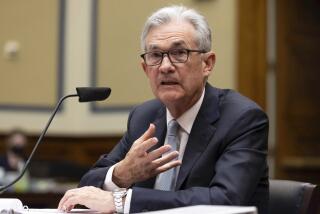GDP Figure Starts With Economists in a Sealed Room
- Share via
WASHINGTON — When the government revealed Friday that the U.S. economy grew at a paltry 1.6% annual rate in the first quarter, many economists were surprised.
But not Brent Moulton -- he knew the disappointing news last Tuesday after seeing a tentative estimate.
Moulton, associate director for national economic accounts with the Commerce Department’s Bureau of Economic Analysis, is one of a select group privy to one of the nation’s most closely guarded secrets.
He and about 90 BEA staffers in a nondescript Washington building compile the gross domestic product estimate, a single number that attempts to represent the total output of the domestic economy, and the pace with which it grew or shrank.
That number -- the economy’s speedometer -- holds enormous importance.
For example, the White House on Friday cited the slow-growth rate as a reason for tax cuts. And Wall Street, expecting a faster rate of 2.3%, was spooked and the Dow Jones industrial average slid more than 133 points.
There is intricacy as well as secrecy in the process.
The final review began at noon Thursday when a dozen staffers were “locked down” on the sixth floor.
This meant a portion of the floor, including kitchen and restrooms, was sealed from the rest of the building by locked doors.
A bureau official handed out a packet of 30 legal-paper-sized tables to the group. The tables included estimates of everything from U.S. truck production to the amount spent on stock brokerage fees by households.
These tables are the nuts and bolts of the GDP, and they must be right for the overall number to be correct.
GDP is the sum of five components: spending by consumers; fixed investment -- consisting of residential housing or new plants and equipment for businesses; changes in inventory levels; government spending; and the net value of exports of goods and services abroad.
Before this day, staffers spent weeks gathering and studying government and industry data.
As the lockdown approached, BEA economists honed their estimates for each building block. A few days before, the blocks were put together and a tentative estimate was born -- that was Tuesday.
On Thursday afternoon, BEA Director Steve Landefeld formally signed off on the estimate. He also approved a 13-page news release, a copy of which was delivered to the White House’s Council of Economic Advisors, the exception to the lockdown. The rest of the releases were stored securely,
On GDP day, the releases went to the Commerce Department, where staffers handed them out to reporters. The reporters were kept behind closed doors for an hour until they could inform the waiting world at 8:30 a.m. sharp.
The tight security is intended to maintain the integrity of the number, officials say.
The tradition of secrecy governs even the lips of staffers. During the BEA lockdown, the main number, the change in growth, is never spoken aloud.
More to Read
Inside the business of entertainment
The Wide Shot brings you news, analysis and insights on everything from streaming wars to production — and what it all means for the future.
You may occasionally receive promotional content from the Los Angeles Times.










